Poderi Luigi Einaudi
(An Online Virtual Visit)
by
Terry Sullivan
Photos provided by
Poderi Luigi Einaudi
This article describing Poderi Luigi Einaudi is based on the online interview, online data and photos supplied by Poderi Luigi Einaudi. Wines were tasted in Washington DC during March 2020. The article was written during the time of the world-wide 2020 pandemic. Most of our questions were answered by Lorenza L. Abbona, Export Manager, Reception of Clients and Public Relations.
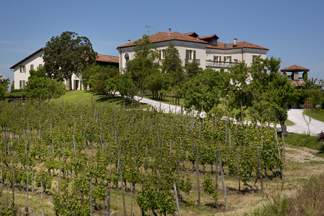 Summary: The Poderi Luigi Einaudi is located in Italy’s Piedmont wine region. History is an important aspect of this winery. Wine enthusiasts can tour the estate, taste the wines and absorb the history of the Einaudi family.
Summary: The Poderi Luigi Einaudi is located in Italy’s Piedmont wine region. History is an important aspect of this winery. Wine enthusiasts can tour the estate, taste the wines and absorb the history of the Einaudi family.
History
In 1897, Luigi Einaudi bought the estate San Giacomo. Now the estate comprises 140 hectares (346 acres). Luigi had many roles during his life. He was a farmer and practiced his farming in the vineyard. For example, in order to control phylloxera, Luigi grafted vines onto American rootstock. He was also an economist and journalist. He is best known as the first elected President of the Italian Republic from 1948 until 1955.
By 1915, a cellar was built to craft and age wines. The first wines were made from Dolcetto grapes. Luigi purchased Barolo vineyards after the Second World War. Four generations of the Einaudi family have crafted wines over the past century. Today, Luigi’s great grandson Matteo Sardagna Einaudi directs the wine estate.
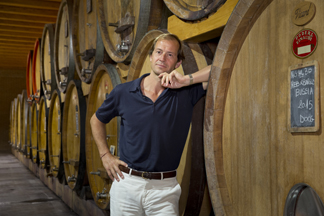 We asked Matteo Sardagna Einaudi (pictured left) to comment about his wine journey.
We asked Matteo Sardagna Einaudi (pictured left) to comment about his wine journey.
Matteo Sardagna Einaudi: My family (in particular my mother Paola and my grandfather Roberto), were able to transmit to me all the love for the world of wine and for the land in which I grew up since I was a child, which is why today I feel so important the need to carry on this company, and to make it grow. When I was a boy I decided to study architecture and to start my career in this sector, but with the time I felt the need to follow my passion for wine and to bring my personal contribution to the company. Now, that I am almost 50, I can only be satisfied and very happy with my choice. We are not a Company that work for business, but a winery with an important past that represents my heredity and my great passion.
Wine Trail Traveler: How does the history of the winery impact the wines of today?
Lorenza L. Abbona: The history gives us the opportunity to use and propose well-known and known labels. However, the quality of the wine has increased a lot since the beginning of the business thanks to the technology and the great passion of the family Eianudi.
Vineyards
The vineyards comprise of 60 hectares (148 acres) on rolling hills. These 60 hectares are spread out. They include the Monvigliero Vineyards planted with Nebbiolo in Verduno. San Giacomo Vineyards in Dogliani, where Dolcetto, Nebbiolo, Merlot and Barbera are planted. Also in Dogliani are the San Luigi Vineyards with Dolcetto and a bit of Barbera, Cabernet Sauvignon, Pinot Grigio and Chardonnay, and the Madonna Delle Grazie Vineyards with Dolcetto. To the north in Neive is the Bric Micca Vineyard planted with Nebbiolo and Merlot. Two vineyards are in the Barolo area. Terlo Vineyards is planted with Nebbiolo, and Cannubi Vineyards perhaps one of the most famous vineyards in Italy, is planted with Nebbiolo. To the east of Barolo is Monforte d’Alba where the Bussia Vineyards lie. These vineyards are planted with Nebbiolo.
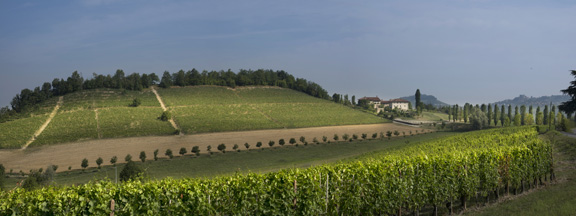
Lorenza commented about the “truly important variety of terroir” making up their vineyards. “Here, according to the sub-area under consideration, it is possible to identify very different mineral components that give the wines unique and particular expressions. Marly soils give elegance and balsamicity, while more sandy soils give wines a lot of variety of scents and freshness."
Wine Trail Traveler asked: “What are the growers’ most enjoyable aspects of the vineyards?”
Lorenza L. Abbona: The best thing of our work is that we are in contact with nature every day. Plants, if they are cared for properly, give us a lot of satisfaction and make us proud to be able to do quality more than quantity.
Winemaking
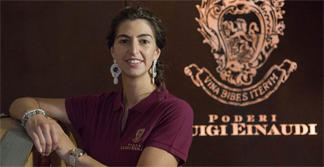 The enologist is Giuseppe Ca Viola who is excited about seeing the wines change from week to week. Lorenza (pictured left) explained that, “The company has invested a lot of energy and finances to buy new vineyards in the Barolo area, partly to increase the quantity of Barolo wine available, and partly to be able to offer different varieties or crus of the same wine. Each one coming from different sub-zones, where we obtain unique expressions.”
The enologist is Giuseppe Ca Viola who is excited about seeing the wines change from week to week. Lorenza (pictured left) explained that, “The company has invested a lot of energy and finances to buy new vineyards in the Barolo area, partly to increase the quantity of Barolo wine available, and partly to be able to offer different varieties or crus of the same wine. Each one coming from different sub-zones, where we obtain unique expressions.”
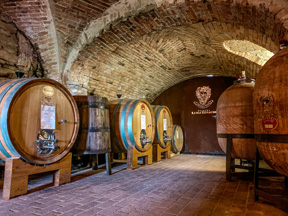 The winery uses stainless steel tanks, oak barrels and casks, and cement tanks for the wine production.
The winery uses stainless steel tanks, oak barrels and casks, and cement tanks for the wine production.
Wine Tourism
Poderi Luigi Einaudi offers three different winery tour experiences ranging in times from 90 minutes to 150 minutes. The 90 minute tour From Dogliani to Barolo includes a guided tour of the cellar and a tasting. Nebbiolo’s Expressions is a two-hour tour of the cellar and tasting. Nebbiolo’s Expressions Over Time is a 2 ½ hour tour including the wine production area, cellar and tasting.
With the cellar built underground and having a zero environmental impact, the cellar tour is educational. Lorenza said of the tours, “It is a well-kept environment where you can breathe history and love for wine.” Wine tours are offered in Italian and English.
Wines
The 2016 Barolo “Cannubi” DOCG was made with Nebbiolo grapes from the Cannubi Cru, one of the most famous crus in Italy. Gray white marne of Sant’Agata which consists of 55% clay, 30% sand and 15% limestone make up the Cannubi Cru. The wine was fermented and macerated for over three weeks. The wine was then racked to large barrels where it aged for 30 months. Afterwards the wine continued to age in bottles. This Barolo had a translucent garnet color and had 14.5% alcohol. Flower and cherries were on the aroma. The taste offered cherries, violets and some baking spices. The wine had a silky mouthfeel and was full bodied with bold tannins. Fruit and spices were on the finish.
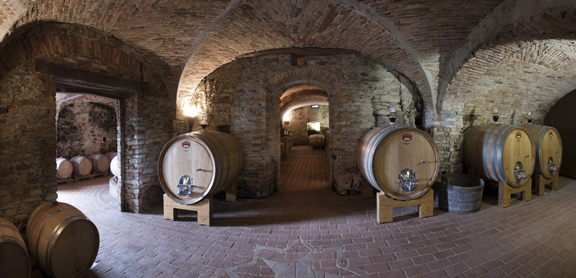
The 2016 Barolo “Ludo” DOCG was a blend of Nebbiolo from three crus: Cannubi, Terlo and Bussia. The wine was fermented and macerated for 16 days. Half of the wine aged in large oak barrels for 30 months, while the other half aged in barriques for 18 months. The wine was then racked to large barrels for an additional year. After bottling, the wine aged for 8-9 months before being released. The wine had a translucent garnet color and had 14% alcohol. The aroma offered perfume and cherry notes. The taste included violets and cherries along with tobacco and baking spices. The velvety wine was medium/full bodied and had bold tannins. The finish was fruity and spicy.
The 2016 Barolo Terlo “Vigna Costa Grimaldi” DOCG was crafted with Nebbiolo grapes from the Costa Grimaldi vineyard in the Terlo zone. The vineyard was composed of a marly- calcareous soil. The fermentation/maceration lasted for 24 days. Thirty months of aging took place in large oak barrels followed by 8-9 months in bottles. The wine had a translucent garnet color with a sienna hue. The 14.5% alcohol wine had perfume and red berries on the aroma. The taste included cherries, red raspberries and licorice. The velvety mouthfeel was accompanied by bold tannins on the full-bodied wine. The finish had fruit and spice notes.
These three wines would pair nicely with meats and cheeses. Some of the local foods that pair well with the wines include Petizers like Battuta al coltello or Vitello Tonnato, as well as Piedmontese cheese.
When visiting the Piedmont region of northern Italy, make an appointment to take one of the tours at Poderi Luigi Einaudi. Sample the wines and absorb the history.
Address
Poderi Luigi Einaud
Dogliani, 12063 Province of Cuneo, Italy
Article written November 2020.
Visit these tour operators that partner with Wine Trail Traveler.
 |
||||
|
Spain and Portugal |
SmoothRed London, England, United Kingdom |
